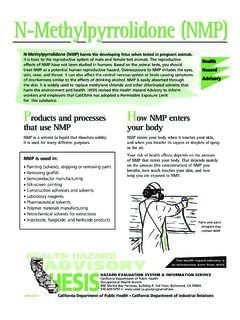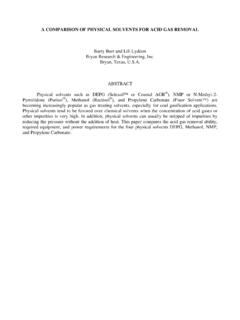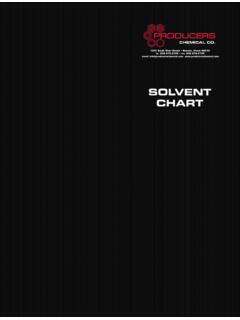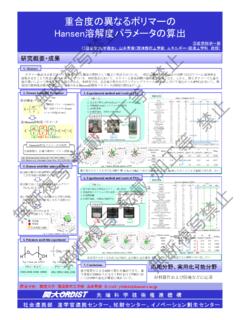Transcription of Nestlé Guidance Note on Packaging Inks
1 Page 1 of 7 Published: Previous version: October 2018 September 2016 Nestl Guidance Note on Packaging Inks October 2018 P U R P O S E This document is a part of the Nestl Packaging Safety and Compliance Program and specifically addresses inks used for the outside of Nestl Packaging materials. This document equally applies to: printing inks, primers and overprint lacquers/coatings/varnishes which are applied by conventional press or digital ink processes. These different ink designations will be referred to as ink in this document.
2 This document must be shared with Nestl vendors and upwards in the Packaging value chain ( with ink makers, ink ingredient makers, ink coating and overprint varnish manufacturers). C O N T E N T S Page General Requirements Regulations 1 General Requirements Sustainability and Recyclability 2 General Requirements Exclusions 2 P I G M E N T S and Table 1: Exclusion list for Pigments 3 P H O T O I N I T I A T O R S and Table 2: Exclusion list for Photoinitiators (energy cured printing) 4 P H O T O I N I T I A T O RS and Table 3: Minimize list for Photoinitiators (energy cured printing) 4 A C R Y L A T E S and Table 4.
3 Exclusion list for Acrylates (energy cured printing) 5 A C R Y L A T E S and Table 5: Minimize list for Acrylates 5 SO L V E N T S and Table 6: Exclusion list for Solvents 6 SO L V E N T S and Table 7: Minimize list for Solvents 6 G E N E R A L R E Q U I R E M E N TS Regulations: Local legislation for food Packaging inks must be followed where one exists. In addition, inks must also be formulated to comply with other local regulations such as environmental laws ( REACH, California s Proposition 65, US-EPA TOSCA, etc.). In the absence of local legislation, Nestl requires inks to be formulated using ingredients that are listed in the Swiss Ink Ordinance on Materials and Articles and respect the migration limits contained therein.
4 Page 2 of 7 Published: Previous version: October 2018 September 2016 Summary of the Swiss Ordinance for food Packaging inks requirements: Part A lists chemical substances that have been toxicologically evaluated and a Specific Migration Limit (SML) has been set for each substance. Part B lists chemical substances which have not been toxicologically evaluated but are still allowed to be used in ink formulations with the default migration limit set at mg/kg (10 ppb) for food or food simulant. The applicable migration limits must be respected for substances in part A and part B in order to fully comply with the Swiss Ink Ordinance requirements.
5 Substances not listed in the Swiss Ink Ordinance are not allowed to be used in any part of a food Packaging ink formulation. Principally, the Swiss inks ordinance must be followed first and foremost. Exceptions may be granted for ink chemicals used outside of Europe which are specifically permitted by local food Packaging ink regulations which include a toxicological evaluation ( US-FDA FCN). These ink chemicals are exceptionally allowed for use in Nestl Packaging provided these chemicals are not prohibited elsewhere in this document.
6 For these exceptions, the supplier must include a reference to the specific regulation ( FCN number) as a part of the compliance statement to the Nestl requirements. Sustainability and Recyclability for inks: Nestl s goals of sustainability and recyclability for food Packaging must extend to inks. This means going forward, ink manufacturers must take into consideration and start formulating inks using components which are more environmentally and recyclability friendly. General exclusions for ink formulations: This Note has negative lists of components.
7 The components below are allowed by the Swiss Ink Ordinance, but are forbidden for Nestl ink formulations due to quality and safety concerns. Titanium Acetyl Acetonate (TAA) must not be used as an adhesion promoter. ortho-Phthalate (commonly called phthalate) plasticizers must not be used. Bisphenol A (BPA) and materials manufactured from or incorporating BPA in reacted form as part of the chemical structure must not be used where safe suitable alternatives exist. Any BPA residue/cross contamination must not be detected in food product from ink above ppb.
8 SVHC must not be used where suitable alternatives exist. Nitrocellulose resins must not be used for ovenable/microwavable Packaging that is heated with food prior to consumption due to decomposition concerns. Vegetable oils/fatty acid esters with strong odours must not be used (for offset inks) Heavy/Toxic metal restrictions and regulations must be followed: o Migration limitations are listed in the Swiss inks ordinance for barium, cobalt, zinc, arsenic, and other metals which must be respected. o Regulations for metals where a product is sold must be followed and can be significantly lower than 100ppm.
9 Check local regulations to confirm compliance to limits for incidental presence of lead, mercury, chromium+6, cadmium, and other metals. Page 3 of 7 Published: Previous version: October 2018 September 2016 Press washes and fountain solutions must not contain solvents and other chemicals which give off-odour or taint to the food. P I G M E N T S Rhodamine-based ( Fanal ) pigments may contain residual rhodamine, which is a suspected carcinogenic substance. These pigments are generally less stable (visual aspect changes, migrations).
10 The prohibited pigments are listed in Table 1. Table 1: Exclusion list for Pigments Pigments Color index CAS number Swiss Ink Ordinance Pigment Red 81 45160:1 12224-98-5 B Pigment Red 81:1 45160:3 80083-40-5 B Pigment Red 81:2 45161:1 75627-12-2 B Pigment Red 81:3 45161:2 68310-07-6 B Pigment Red 81:5 45160:4 63022-06-0 B Pigment Red 169 45160:2 12237-63-7 B Pigment Green 1 42040:1 1325-75-3 B Pigment Blue 1 1325-87-7 B Pigment Blue 62 44084 57485-98-0 B Pigment Violet 1 45170:2 1326-03-0 B Pigment Violet 2 45175.






